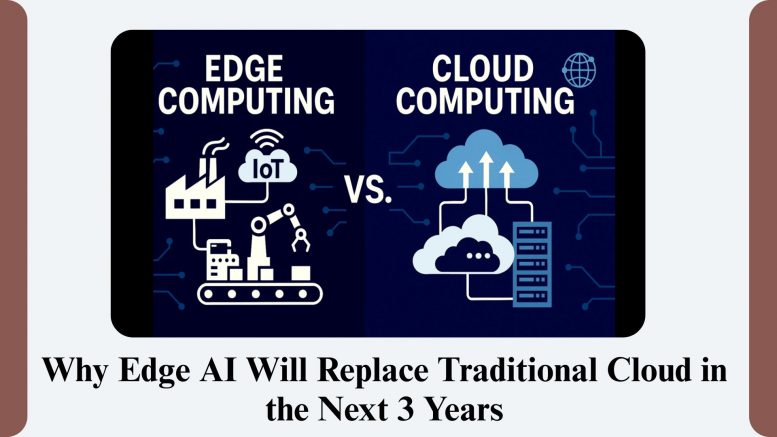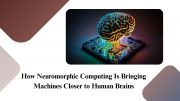In a global increasingly more reliant on data-pushed intelligence, Edge AI is rapidly emerging as a disruptive force that’s poised to overtake conventional cloud-based totally computing models. As corporations, governments, and even homes come to be more interconnected, the want for quicker processing, lower latency, and real-time choice-making is becoming non-negotiable.
Over the next 3 years, Edge AI will possibly replace or substantially supplement conventional cloud infrastructure now not due to the fact the cloud is out of date, however due to the fact area computing represents an evolution that better aligns with our growing demands for speed, intelligence, privateness, and autonomy.
This article will explore the technological “brain shift” it is underway explaining what Edge AI is, why it’s advanced in lots of situations, and the way it’s set to redefine the future of computing.
What is Edge AI?
Edge AI is the deployment of Artificial Intelligence algorithms immediately on devices or at the “edge” of the community closer to wherein information is generated instead of relying on a centralized cloud server. These part gadgets could be smartphones, IoT devices, safety cameras, commercial machines, motors, drones, or even wearables.
Key capabilities of Edge AI include:
- Real-time data processing
- On-device machine learning inference
- Minimal latency and bandwidth use
- Enhanced data privacy
While traditional cloud computing sends records to distant facts middle for processing and analysis, Edge AI procedures statistics regionally, presenting immediate insights without needing consistent cloud interaction.
What’s Next for Edge and AI?
The subsequent wave of Edge AI will flow beyond inference to include on-device schooling, allowing machines to constantly study from their surroundings. As chipsets grow to be more effective and strength-green, facet devices will evolve into autonomous, wise nodes able to model without cloud dependency.
Integration with 5G, neuromorphic computing, and federated learning will push boundaries even in addition. This method smarter factories, responsive towns, personalized healthcare, and vehicles that no longer simplest suppose fast but analyze speedy, too.
In short, Edge AI becomes the foundation of sensible infrastructure, powering a related international that’s faster, more secure, and extra intuitive than ever earlier than.
Why the Cloud is Losing Ground
Cloud computing has been the backbone of AI evolution over the past decade. It enabled massive data storage, high processing power, and centralized AI training. But its limitations are now being exposed by real-world use cases.
1.Latency Issues
Cloud systems inherently suffer from latency due to the distance data must travel. This is unacceptable in:
- Autonomous vehicles (decisions must be in milliseconds)
- Remote surgeries (delay can be fatal)
- Smart manufacturing (downtime is costly)
Edge AI ensures zero-to-minimal delay by processing data right where it originates.
2.Bandwidth Bottlenecks
With the explosion of devices and records (specially video, audio, and sensor feeds), sending the entirety to the cloud clogs bandwidth and increases fees. Edge AI reduces this load with the aid of filtering and analyzing statistics regionally, and best transmitting what is vital.
3.Privacy and Data Sovereignty
Sensitive industries like healthcare, defense, and finance can’t come up with the money for to send all facts to the cloud. Edge AI continues sensitive data local, ensuring compliance with policies such as GDPR, HIPAA, and others.
4.Cost of Centralization
The price of transmitting, storing, and processing petabytes of statistics centrally is skyrocketing. Edge AI distributes the load and reduces the need for steeply-priced statistics center enhancements and bandwidth enlargement.
The Advantages of Edge AI Over Traditional Cloud
Speed and Real-Time Intelligence
Edge AI enables instant insights without spherical-trip cloud latency. Think of it because the human mind’s capability to reply to stimuli without awaiting relevant nervous gadget processing.
Operational Resilience
Devices powered by using Edge AI can preserve to function even though net connectivity is lost. In assignment-important applications like drones, commercial robots, and scientific gadgets, this autonomy is crucial.
Scalability
Rather than scaling centralized infrastructure to house billions of IoT gadgets, Edge AI lets each device deal with its own intelligence a decentralized and infinitely scalable version.
Customizable Local Experiences
Edge AI permits local, context-conscious personalization. For instance, smart retail cabinets or home gadgets can adapt in actual time based totally on person interplay and possibilities without calling returned to the cloud.
Real-World Use Cases Driving the Shift
1.Autonomous Vehicles
Self-using motors depend closely on Edge AI to make cut up-second decisions without waiting for cloud processing. Every millisecond counts.
2.Smart Surveillance
AI-powered CCTV Systems can hit upon anomalies (e.G., guns, intruders, fires) in actual-time without sending video feeds to the cloud.
3.Healthcare Monitoring
Wearable health monitors and clinical gadgets can locate irregularities like heart price spikes or seizures immediately using on-tool AI.
4.Industrial IoT
Edge AI allows predictive preservation, disorder detection, and automation in factories, reducing downtime and improving safety.
5.Retail and Customer Experience
Smart mirrors, merchandising machines, and interactive kiosks deliver hyper-customized reports by using processing consumer information locally.
The Technological Brain Analogy
Just because the human mind doesn’t route every sensory enter to a relevant region for interpretation, Edge AI mimics a neural model processing locally at synaptic factors to make certain on the spot response.
Edge AI acts as the “frightened system” for the Internet of Things (IoT), pushing intelligence to every node, similar to how reflexes skip the brain for quicker reaction. The conventional cloud, in comparison, represents centralized wondering slower, less adaptive, and increasingly out of contact with the brink reality.
Market Trends and Predictions
According to IDC, by 2027:
- More than 65% of AI workloads will be processed at the edge
- Edge AI devices will exceed 100 billion globally
- Edge spending will surpass $300 billion annually
Big tech is already moving fast:
- Google is integrating Edge TPU in Android and IoT devices.
- Apple uses on-device AI for Face ID, Siri, and photo recognition.
- Amazon has AWS Greengrass to enable local ML on edge devices.
- NVIDIA is pushing Jetson modules for robotics and smart cities.
- Qualcomm, Intel, and ARM are building AI-ready edge chipsets.
Challenges to Overcome
Despite its promise, Edge AI adoption still faces hurdles:
1.Hardware Limitations
Edge devices must balance performance, power, and size. But new chip architectures (like RISC-V, neural processing units) are solving this.
2.Model Optimization
Heavy AI fashions ought to be compressed and quantized to run efficiently on facet hardware. Tools like TensorFlow Lite, ONNX, and PyTorch Mobile are addressing this.
3.Security Risks
More devices mean more endpoints to protect. But robust firmware updates, encryption, and hardware-level security are evolving rapidly.
4.Standardization
There is still fragmentation in protocols, platforms, and tools. Industry collaboration is needed to establish unified edge AI frameworks.
Cloud Isn’t Dead It’s Evolving
It’s crucial to note: Edge AI won’t entirely replace the cloud it will redefine its role.
The cloud will remain vital for:
- Model training
- Centralized coordination
- Historical data analysis
- Global app updates and backups
But inference, the actual “thinking,” will increasingly happen at the edge.
Conclusion: A Brain Shift We Can’t Ignore
In the next 3 years, we are not just witnessing a shift in computing architecture we’re Seeing the evolution of intelligence itself. Edge AI is remodelling our gadgets from mere sensors into autonomous agents able to wondering, studying, and appearing right away and intelligently.
This shift parallels the human brain’s decentralized structure, where actual-time decisions are made domestically for survival, while long-term questioning is centralized. The destiny of technology isn’t imperative intelligence it’s collective intelligence at the brink.
Edge AI isn’t always simply the following step. It’s the new brain of the digital global.
Explore extra on how emerging technology are shaping corporations within the IT area:
👉 Information Technology – 1WebsDirectory
Now is the time to improve your tech approach because the threshold is not the future, it’s the existing.
Embrace the shift, or chance being left behind.
Frequently Asked Questions (FAQs)
1.What is Edge AI?
Edge AI runs AI obligations immediately on devices, without relying on cloud servers.
2.How is Edge AI higher than cloud computing?
It offers quicker processing, lower latency, better privacy, and offline capability.
3.Which industries are adopting Edge AI?
Healthcare, automobile, production, retail, and smart surveillance.
4.Will Edge AI replace cloud computing?
Not fully it will handle real-time tasks, while the cloud supports storage and training.
5.Is Edge AI secure?
Yes, especially for local data, but devices still need strong security measures.




Be the first to comment on "Why Edge AI Will Replace Traditional Cloud in the Next 3 Years"